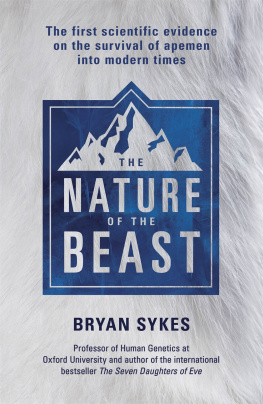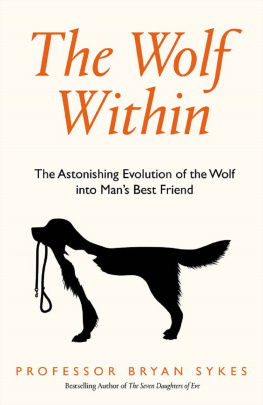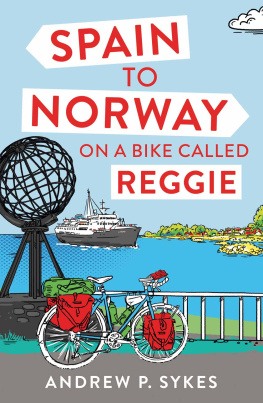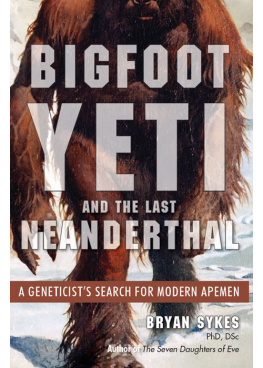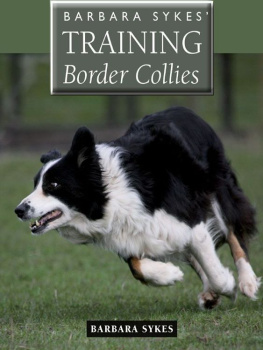THE SEVEN DAUGHTERS OF EVE
BRYAN SYKES
THE
SEVEN DAUGHTERS OF EVE
Copyright 2001 by Bryan Sykes
All rights reserved
For information about permission to reproduce selections from this book, write to Permissions, W. W. Norton & Company, Inc., 500 Fifth Avenue, New York, NY 10110
Library of Congress Cataloging-in-Publication Data
Sykes, Bryan.
The seven daughters of Eve / Bryan Sykes.1st American ed.
p. cm.
ISBN: 978-0-393-32314-6
1. Human population genetics. 2. Human evolution. 3 WomenAnthropometry. 4. Evolutionary genetics. I. Title.
GN289 .S94 2001
599.93'5dc21
2001030820
W. W. Norton & Company, Inc., 500 Fifth Avenue, New York, N.Y. 10110
www.wwnorton.com
W. W. Norton & Company Ltd., Castle House, 75/76 Wells Street, London W1T 3QT
To my mother
CONTENTS
ACKNOWLEDGEMENTS
This book owes many things to many people. Do not imagine for a moment that everything reported here as coming from my laboratory is exclusively my own work. Modern science relies on teamwork and I have been fortunate to have had some very talented people in my research group over the years. In different ways they have all helped in creating this story. In particular I want to thank Martin Richards, Vincent Macaulay, Kate Bendall, Kate Smalley, Jill Bailey, Isabelle Coulson, Eileen Hickey, Emilce Vega, Catherine Irven, Linda Ferguson, Andrew Lieboff, Jacob Low-Beer and Chris Tomkins. In Oxford I must also thank Robert Hedges from the Radiocarbon Accelerator Unit for getting me started on all this, William James, Fellow of most Oxford colleges in his time, for his inspired suggestions along the way and, in London, Chris Stringer of the Natural History Museum for allowing me to drill holes into the fossils in his care. I am very grateful to Clive Gamble for his tutorials on the ancient world. I must also pay particular thanks to Professor Sir David Weatherall for not only tolerating but actually encouraging the performance of such exotic and seemingly pointless research in his Institute of Molecular Medicine in Oxford.
You may also gain the impression that my research group is the only one in the world doing this sort of work. It certainly is not and none of what I describe would have been possible without the pioneering work of, among many others, Luca Cavalli-Sforza, Alberto Piazza, Walter Bodmer, the late Allan Wilson, Svante Paabo, Mark Stoneking, Rebecca Cann, Douglas Wallace, Antonio Torroni, Mark Jobling and Peter Underhill. As you will see, we do not all necessarily agree with one another all of the time; but without them, and many others like them, mine would have been a much harder, and far duller journey.
Four people in particular have helped to bring this story into print. The quiet professionalism of my editor, Sally Gaminara, and the infectious enthusiasm of my agent, Luigi Bonomi, have kept me going. Add to that the thoroughness of Gillian Bromley, my copy editor, and the patience of Julie Sheppard, who typed up my scribbled notes, and few authors could have had more assistance.
I am indebted to the thousands of volunteers who, by giving me their DNA samples, have allowed me to peer into the secrets of their genetic past. Without them there would be no story to tell. Some names have been changed to protect anonymity. I particularly want to thank the government and people of Rarotonga in the Cook Islands for being exceptionally helpful, and Malcolm Laxton-Blinkhorn for his outstanding hospitality during my stays on this delightful island. And lastly, thanks to Janis, Jay, Sue and my son Richard, though only an embryo at the time, for coming with me.
B.S.
THE SEVEN DAUGHTERS OF EVE

PROLOGUE
Where do I come from?
How often have you asked yourself that question? We may know our parents, even our grandparents; not far beyond that, for most of us the trail begins to disappear into the mist. But each of us carries a message from our ancestors in every cell of our body. It is in our DNA, the genetic material that is handed down from generation to generation. Within the DNA is written not only our histories as individuals but the whole history of the human race. With the aid of recent advances in genetic technology, this history is now being revealed. We are at last able to begin to decipher the messages from the past. Our DNA does not fade like an ancient parchment; it does not rust in the ground like the sword of a warrior long dead. It is not eroded by wind or rain, nor reduced to ruin by fire and earthquake. It is the traveller from an antique land who lives within us all.
This book is about the history of the world as revealed by genetics. It shows how the history of our species, Homo sapiens , is recorded in the genes that trace our ancestry back into the deep past, way beyond the reach of written records or stone inscriptions. These genes tell a story which begins over a hundred thousand years ago and whose latest chapters are hidden within the cells of every one of us.
It is also my own story. As a practising scientist, I am very lucky to have been around at the right time and able to take an active part in this wonderful journey into the past that modern genetics now permits. I have found DNA in skeletons thousands of years old and seen exactly the same genes in my own friends. And I have discovered that, to my astonishment, we are all connected through our mothers to only a handful of women living tens of thousands of years ago.
In the pages that follow, I will take you through the excitement and the frustrations of the front-line research that lies behind these discoveries. Here you will see what really happens in a genetics laboratory. Like any walk of life, science has its ups and downs, its heroes and its villains.
ICEMANS RELATIVE FOUND IN DORSET
On Thursday 19 September 1991 Erika and Helmut Simon, two experienced climbers from Nuremberg in Germany, were nearing the end of their walking holiday in the Italian Alps. The previous night they had made an unscheduled stop in a mountain hut, planning to walk down to their car the next morning. But it was such a brilliantly sunny day that they decided instead to spend the morning climbing the 3,516 metre Finailspitze. On their way back down to the hut to pick up their rucksacks they strayed from the marked path into a gully partly filled with melting ice. Sticking out of the ice was the naked body of a man.
Though macabre, such finds are not so unusual in the high Alps, and the Simons assumed that this was the body of a mountaineer who had fallen into a crevasse perhaps ten or twenty years previously. The following day the site was revisited by two other climbers, who were puzzled by the old-fashioned design of the ice-pick that was lying nearby. Judging by the equipment, this alpine accident went back a good many years. The police were contacted and, after checking the records of missing climbers, their first thought was that the body was probably that of Carlo Capsoni, a music professor from Verona who had disappeared in the area in 1941. Only days later did it begin to dawn on everybody that this was not a modern death at all. The tool found beside the body was nothing like a modern ice-pick. It was much more like a prehistoric axe. Also nearby was a container made from the bark of a birch tree. Slowly the realization sank in that this body was not tens or even hundreds but thousands of years old. This was now an archaeological find of international importance.
The withered and desiccated remains of the Iceman, as he soon came to be known, were taken to the Institute of Forensic Medicine in Innsbruck, Austria, where he was stored, frozen, while an international team of scientists was assembled to carry out a minute examination of this unique find. Since my research team in Oxford had been the first in the world to recover traces of DNA from ancient human bones, I was called in to see whether we could find any DNA in the Iceman. It was the irresistible opportunity to become involved in such thrilling discoveries that had persuaded me to veer away from my career as a regular medical geneticist into this completely new field of science, which some of my colleagues regarded as a bizarre and eccentric diversion of no conceivable use or consequence.


